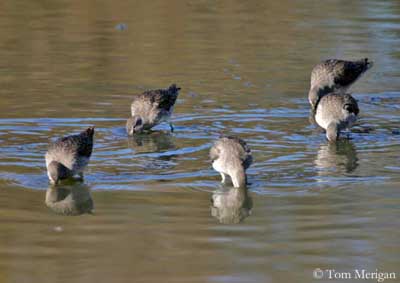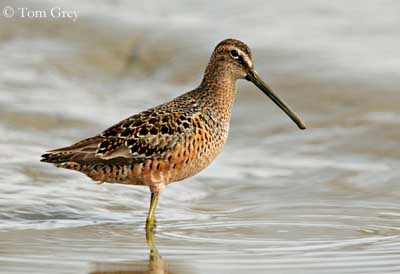
PROTECTION / THREATS / STATUS:
In spite of the increasing of the range, the Long-billed Dowitcher could be threatened by habitat destruction and various pollutions due to human activities.
But currently, the populations appear to increase according to the range, and are not threatened.
Fr: Bécassin à long bec
All : Großer Schlammläufer
Esp: Agujeta Escolopácea
Ital: Limnodromo beccolungo
Nd: Grote Grijze Snip
Sd: Långnäbbad beckasinsnäppa
Photographers:
Tom Grey
Tom Grey's Bird Pictures
Tom Merigan
Tom Merigan’s Photo Galleries
Bob Moul
Nature Photography
Peter Moulton
Pete Moulton Photography
Text by Nicole Bouglouan
Sources :
HANDBOOK OF THE BIRDS OF THE WORLD Volume 3 by Josep del Hoyo-Andrew Elliott-Jordi Sargatal - Lynx Edicions - ISBN : 8487334202
A GUIDE TO THE BIRDS OF MEXICO AND NORTHERN CENTRAL AMERICA by Steve N. G. Howell, Sophie Webb - Oxford University Press - ISBN: 0198540124
GUIDE DES LIMICOLES de D. Taylor - Delachaux et Niestlé - ISBN : 2603014080
SHOREBIRDS by Peter Hayman, John Marchant and Tony Prater – Christopher Helm – 1986 – ISBN: 0747014035
BirdLife International (BirdLife International)
The Birds of North America online
Bird Web (Seattle Audubon Society)
Long-billed Dowitcher
Limnodromus scolopaceus
Charadriiforme Order – Scolopacidae Family
BIOMETRICS:
Length: 27-30 cm - Bill length: 54-78 mm
Wingspan: 46-52 cm
Weight: 90-135 g
DESCRIPTION:
The Long-billed Dowitcher is a medium-sized North American shorebird which regularly reaches the western coasts of Europe during its migration.
In breeding plumage, underparts are reddish. The foreneck is spotted brown. Breast and flanks are spotted and barred with paler colour, and the belly is slightly paler and uniform. The underwing is mostly pale grey.
The upperparts are brown with fine rufous edges and whitish-tipped feathers. An elongated white patch ending in a point is visible in the centre of the back when the wings are spread.
The wings have dark brown tips. The secondary flight feathers are edged white and a narrow white trailing edge is visible in flight.
The tail shows black bars interspersed with narrower white bars.

Bill and tarsi are fairly long. The head is brown on the crown. We can see a whitish stripe from the bill base to the ear-coverts. Lores are dark brown. The long bill is blackish-brown. The eyes are dark brown, surrounded by narrow white eye-ring. Legs and feet are greenish-yellow.
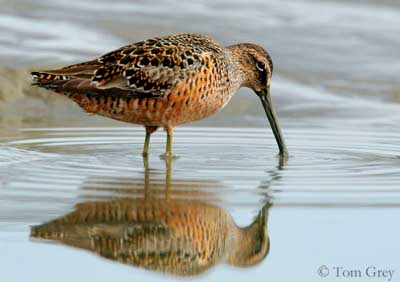
In winter plumage, the bird is greyer and duller overall. The belly is white. The breast is grey and the flanks are barred grey and white. The upperparts are brown, less marked than in spring.
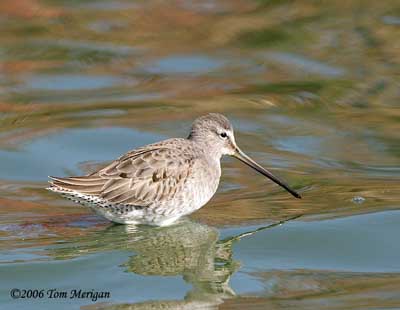
The female is slightly larger than male.
The juvenile is darker grey with narrower edges on the upperparts.
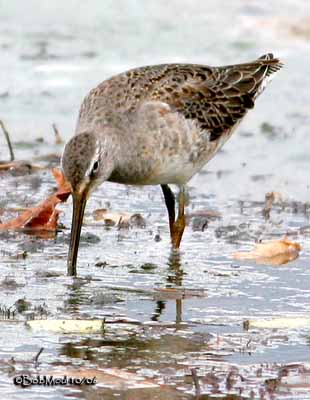
VOICE: SOUNDS BY XENO-CANTO
The Long-billed Dowitcher’s call is a sharp peeping “kik” and usually only one is uttered, but sometimes, we can hear series rapidly repeated. The alarm call is the same sound but longer “kiiik”.
The song is a rapid phrase « pee-ter-wee-too » entirely or partially repeated. This song is given by the male during the flight displays.
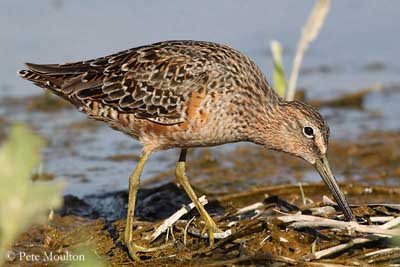
HABITAT:
The Long-billed Dowitcher frequents the grassy marshes with reeds, the swamps in arctic tundra, the shores of shallow lakes, the flooded plains and the wet tundra.
During migration and winter, it can be found mainly close to freshwaters, marshes and drying lake shores, pools and mudflats, and sometimes in coastal areas.
RANGE:
The Long-billed Dowitcher breeds in N and W Alaska arctic coasts, Canada and NE Siberia.
It winters on Atlantic and Pacific coasts, and in southern United States, Mexico and Central America.
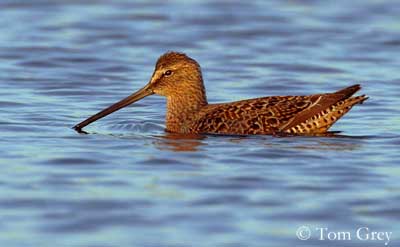
BEHAVIOUR:
The Long-billed Dowitcher feeds by probing the mud with its long bill while wading. Sometimes, the head is entirely submerged. It has very sensitive bill tip and detects the preys by touch in the mud. It walks slowly, with the head moving up and down.
It feeds on insect larvae, small snails and crustaceans, and also takes seeds and other plant matter.
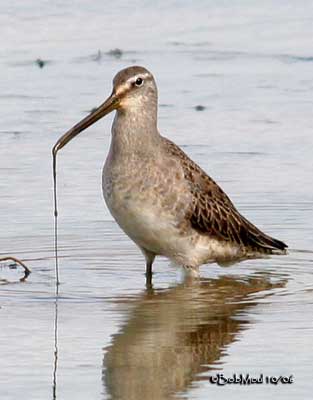
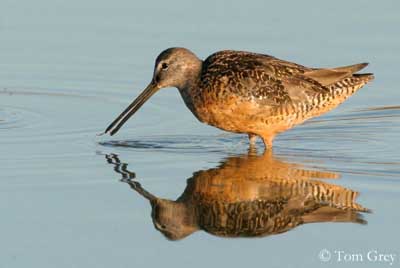
This gregarious species is usually seen in small groups.
Flight displays are observed. The male performs hovering flights while singing. Two or three males perform chases after one female in flight.
The Long-billed Dowitcher is migratory. The females move first, the males follow them, and the juveniles move after the adults.
FLIGHT:
The Long-billed Dowitcher performs fast and acrobatic flights during the courtship displays. In flight, the legs are projected beyond the tail.
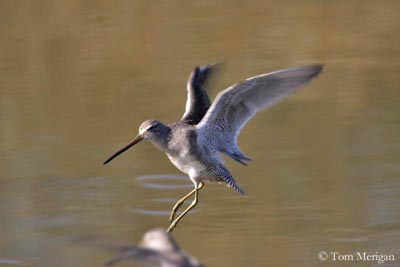
REPRODUCTION:
The breeding season occurs between late May and August.
The Long-billed Dowitcher is monogamous. The nest is built by the female. It is situated close to the water, usually in clump of sedge, and it is often damp at the bottom.
The female lays four brown eggs spotted dull green. The incubation lasts about three weeks, shared by both parents. The chicks leave the nest one day after hatching and are able to feed themselves. They are reared by both adults.
The female leaves the family group very soon after the hatching. The young fly about 19-20 days later. The male guards them until they fledge, between 20 and 30 days after hatching. This species produces a single brood per season.
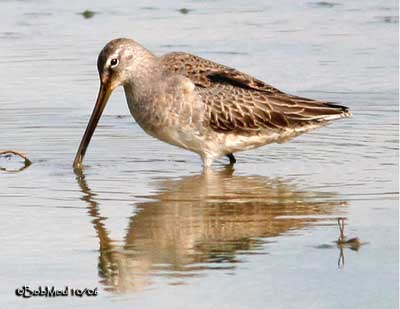
DIET:
The Long-billed Dowitcher feeds on coleopterans, crustaceans, small snails, seeds and some plant matter. On the breeding grounds, it feeds mainly on insects and their larvae. It finds molluscs, marine worms and aquatic invertebrates in mudflats.
